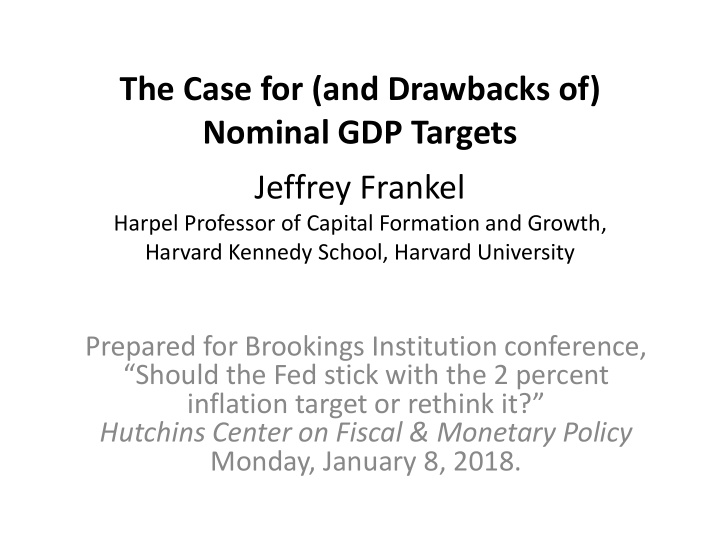



The Case for (and Drawbacks of) Nominal GDP Targets Jeffrey Frankel Harpel Professor of Capital Formation and Growth, Harvard Kennedy School, Harvard University Prepared for Brookings Institution conference, “Should the Fed stick with the 2 percent inflation target or rethink it ?” Hutchins Center on Fiscal & Monetary Policy Monday, January 8, 2018.
To start Basic principle: The point of announcing a target is credibility; therefore the target is less useful if the authorities are chronically unable to achieve it. 1) The main point of promising to raise inflation to 2% was to get the economy back to full employment. • The 2% goal no longer serves the purpose envisioned, – since it hasn‘t been achieved & lacks credibility; – and unemployment is back down nevertheless . – Raising the inflation target to 4% or setting a price level target would be even less credible. • But it is fine for the central bank to be transparent about what it sees as the long-run inflation rate (“FIT”).
2) More important question: if the central bank wants to communicate its intentions at a 1- or 2- year horizon, how should it express the signal? • Obvious choices for a nominal target: – Inflation? – M1? – Exchange rate? • Other candidate variables for signaling: – short interest rates? – the unemployment rate? – real GDP targets?
The proposal 3) If central banks want to communicate their intentions at a 1-2 year horizon, it would be more effective to do so phrased in terms of Nominal GDP than in terms of CPI inflation. • The proposal could be as mild as adding a row for NGDP to the FOMC’s Summary of Economic Projections submitted by the Governors and district presidents. – I’d prefer the SEP table reports NGDP in 1st row • before real growth, unemployment, CPI, & fed funds rate.
Table 1 of the Summary of Economic Projections to be released with the FOMC minutes Economic projections of Federal Reserve Board members and Federal Reserve Bank presidents under their individual assessments of projected appropriate monetary policy, December 2017. Δ NGDP For release Dec. 13, 2017
What is the case for NGDPT? 4) NGDPT dominates a money target. History: – The proposal arose (1980s) when the alternative was M1. – After monetarist rules broke down, the robustness of nominal GDP targeting was pointed out by Meade (1978, 1982) & Tobin (1980, 83), followed by many others. – “Robustness” ≡ the target’s ability to hold up ex post under various shocks. • Relative to the M1 growth rule, the advantage of nominal GDP targeting was robustness with respect to velocity shocks.
5) NGDPT underwent a revival around 2011-12, under quite different circumstances. – E.g., Romer (2011) & Krugman (2011); Hatzius (2011); Woodford (2012); Sumner (2014) & Beckworth (2016); Frankel (2012) & Bhandari & Frankel (2017); Koenig (2013), Sheedy (2014), & Bullard et al. (2015). – The alternative to beat: no longer M1, but a CPI target. • The case in favor of a nominal GDP target is still its robustness with respect to shocks. But relative to a CPI inflation target, the advantage of NGDPT is robustness with respect to Aggregate Supply shocks – such as productivity shocks or commodity shocks.
• In the presence of an adverse supply shock, an inflation target implies a tight monetary policy. – NGDP targeting allows the impact of the shift to be automatically divided between some loss of price stability and some loss on the output objective … • …whereas an ex ante inflation target can push the authorities to tighten in the face of an adverse shock, thereby needlessly worsening the fall in output. – E.g., the ECB decision in July 2008 to raise interest rates just as the world was sliding into the Great Recession. • See graph.
6. What are the drawbacks of NGDPT? • i) The central bank can’t hit Nominal GDP targets. – But the same is true of inflation targets. • ii) The person in the street does not understand nominal GDP, how it breaks down into real GDP vs P. – All the more reason to avoid choosing an ex ante target (CPI) that in the event of an adverse supply shock must be abandoned amid feeble explanations. • iii) Nominal GDP numbers are revised ex post. – This does seem a valid drawback of NGDPT; but not fatal. Thank you.
Recommend
More recommend